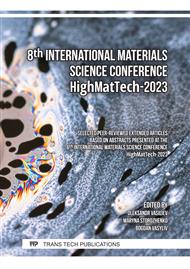[1]
P. Kuznietsov, A. Tykhomyrov, O. Biedunkova, S. Zaitsev, Improvement of methods for controlling power oil of cooling tower recycling water supply units at Rivne nuclear power plant. Scientific Horizons, 12(25), (2022) 69-79.
DOI: 10.48077/scihor.25(12).2022.69-79
Google Scholar
[2]
P.N. Kuznetsov, A.U. Tichomirov, Water-chemistry operating condition of the second circuit power units №1-4 Rivne NPP with ethanolamine`s corrective treatment. Problem At. Sci. Technol. 2 (2017) 109-113.
Google Scholar
[3]
D.A. Meier, B. Chen, C. Myers, Cooling water systems: An overview. Water-Formed Deposits. (2022) 239-267.
DOI: 10.1016/b978-0-12-822896-8.00020-0
Google Scholar
[4]
D.D. Macdonald, G.R. Engelhardt, Critical Review of Radiolysis Issues in Water-Cooled Fission and Fusion Reactors: Part II, Prediction of Corrosion Damage in Operating Reactors. Corros. Mater. Degrad. 3 (2022) 4 694-758.
DOI: 10.3390/cmd3040038
Google Scholar
[5]
A. Zaza, EG Bennouna, N.E. Laadel, Y.E. Hammami, Experimental Study of Fouling in Hybrid Cooling Tower Used in CSP Plants: Effects of the Polymer and galvanized steel tubes. Therm. Sci. Eng. Prog. 25 (2021) 101005.
DOI: 10.1016/j.tsep.2021.101005
Google Scholar
[6]
D. Feron, Nuclear Corrosion Science and Engineering. Woodhead Publishing, 2016 1072.
Google Scholar
[7]
P.M. Kuznietsov, O.O. Biedunkova, O.V. Yaroshchuk, Experimental study of transformation of carbonate system components cooling water of Rivne Nuclear Power Plant during water treatment by liming. Problem At. Sci. Technol. 144 (2023) 69-73.
DOI: 10.46813/2023-144-069
Google Scholar
[8]
M. Taleb-Berrouane, F. Khan, K. Hawboldt, Corrosion risk assessment using adaptive bow-tie (ABT) analysis. Reliab. Eng. Syst. Saf. 214 (2021) 107731.
DOI: 10.1016/j.ress.2021.107731
Google Scholar
[9]
M. Liu, Effect of uniform corrosion on mechanical behavior of E690 high-strength steel lattice corrugated panel in marine environment: a finite element analysis. Mater. Res. Express. 8 (2021) 6 066510.
DOI: 10.1088/2053-1591/ac0655
Google Scholar
[10]
B.J. Little, D.J. Blackwood, J. Hinks, et al., Microbially influenced corrosion – Any progress? Corros. Sci. 170 (2020) 1-17.
DOI: 10.1016/j.corsci.2020.108641
Google Scholar
[11]
K. Rahmani, R. Jadidian, S. Haghtalab Evaluation of inhibitors and biocides on the corrosion, scaling and biofouling control of carbon steel and copper–nickel alloys in a power plant cooling water system. Desalination. 393 (2016) 174-185.
DOI: 10.1016/j.desal.2015.07.026
Google Scholar
[12]
X. Yang, J. Shao, Z. Liuet, et al. Stress-assisted microbiologically influenced corrosion mechanism of 2205 duplex stainless steel caused by sulfate-reducing bacteria. Corros. Sci. 173 (2020) 108746.
DOI: 10.1016/j.corsci.2020.108746
Google Scholar
[13]
B. Tribollet, Microbiologically influenced corrosion (MIC) in nuclear power plant systems and components. Corros. Eng. Sci. Technol. (2012) 230-261.
DOI: 10.1533/9780857095343.2.230
Google Scholar
[14]
A. Rajasekar, B. Anandkumar, S. Maruthamuthu, et al., Characterization of corrosive bacterial consortia isolated from petroleum-product-transporting pipelines. Appl. Microbiol. Biotechnol. 85 (2009) 4. 1175-1188.
DOI: 10.1007/s00253-009-2289-9
Google Scholar
[15]
H.A. Videla, L.K. Herrera, Understanding microbial inhibition of corrosion. A comprehensive overview. Int. biodeterioration. biodegradation (63) 2009 896-900.
DOI: 10.1016/j.ibiod.2009.02.002
Google Scholar
[16]
V.P. Venugopalan, S. Rajagopal, H.A. Jenner, Operational and Environmental Issues Relating to Industrial Cooling Water Systems: An Overview. Operational and Environmental Consequences of Large Industrial Cooling Water Systems. Boston, MA, 2011. pp.1-12.
DOI: 10.1007/978-1-4614-1698-2_1
Google Scholar
[17]
F. Barton, S. Shaw, K. Morris, et al., Impact and control of fouling in radioactive environments. Prog. Nucl. Energy. (148) 2022 104215.
DOI: 10.1016/j.pnucene.2022.104215
Google Scholar
[18]
K. Alasvand Zarasvand, V.R. Rai Microorganisms: Induction and inhibition of corrosion in metals. Int. biodeterioration. biodegradation 87 (2014) 66-74.
DOI: 10.1016/j.ibiod.2013.10.023
Google Scholar
[19]
A. Rochdi, O. Kassou, N. Dkhireche, et al., Inhibitory properties of 2,5-bis(n-methylphenyl)-1,3,4-oxadiazole and biocide on corrosion, biocorrosion and scaling controls of brass in simulated cooling water. Corros. Sci. 80 (2014) 442-452.
DOI: 10.1016/j.corsci.2013.11.067
Google Scholar
[20]
H.-W. Luo, M. Lin, X.-X. Bai, et al., Water quality criteria derivation and tiered ecological risk evaluation of antifouling biocides in marine environment. Mar. Pollut. Bull. 187 (2023) 114500.
DOI: 10.1016/j.marpolbul.2022.114500
Google Scholar
[21]
V.R. Unamuno, E. van de Plassche, L. van der Wal, Biocides. Reference Module in Biomedical Sciences. 2022
DOI: 10.1016/b978-0-12-824315-2.00115-9
Google Scholar
[22]
P. Kuznietsov, O. Biedunkova Experimental Tests of Biocidal Treatment for Cooling Water of Safety Systems at Rivne NPP Units. Nucl. Radiat. Saf. 97 (2023) 30-40
DOI: 10.32918/nrs.2023.1(97).04
Google Scholar
[23]
S. Fernandes, I.B. Gomes, M. Simões Antimicrobial and antibiofilm potentiation by a triple combination of dual biocides and a phytochemical with complementary activity. Food Res. Int. 167 (2023) 112680.
DOI: 10.1016/j.foodres.2023.112680
Google Scholar
[24]
Information on https://www.energoatom.com.ua/ (Standart in Ukraine SOU NAEK 067:2013).
Google Scholar
[25]
Generalized list of maximum permissible concentrations (MPC) and tentatively safe levels of exposure (VZUV) of harmful substances for the water of fishing reservoirs. Ministry of Agriculture (1990) http://online.budstandart.com/ua/catalog/doc-page.html ?id_doc=75723
Google Scholar
[26]
R. Cristiani, G. Perboni, A. Debenedetti, Effect of chlorination on the corrosion of Cu/Ni 70/30 condenser tubing. Electrochim. Acta. 54 (2008) 100-107.
DOI: 10.1016/j.electacta.2008.05.081
Google Scholar
[27]
J.V. Simpson, C.L. Wiatr, Quantification and Degradation of 2,2-Dibromo-3-Nitrilopropionamide (DBNPA) in Bioethanol Fermentation Coproducts. World. J. Microbiol. Biotechnol. 38 (2022) 82-111.
DOI: 10.1007/s11274-022-03253-0
Google Scholar
[28]
A. Lindberg, O. Diaz-Morales, S. Holmin, Cornell Sources of Oxygen Produced in the Chlorate Process Utilizing Dimensionally Stable Anode (DSA) Electrodes Doped by Sn and Sb. Ind. Eng. Chem. Res. 60 (2021) 13505-13514.
DOI: 10.1021/acs.iecr.1c02004
Google Scholar
[29]
F.A. Blanchard, S.J. Gonsior, D.L. Hopkins, 2,2-Dibromo-3-nitrilopropionamide (DBNPA) chemical degradation in natural waters: Experimental evaluation and modeling of competitive pathways. Water Res. 21 (1987) 801-807.
DOI: 10.1016/0043-1354(87)90155-2
Google Scholar
[30]
X. Li, H. Wang, X. Hu, C. Hu, et al., Characteristics of corrosion stains and biofilm in aged pipe distribution systems with switching water sources. Eng. Fail. Anal.60 (2016) 166-175.
DOI: 10.1016/j.engfailanal.2015.11.048
Google Scholar
[31]
Information on https://inconsulting.com.ua/gost/gost-17217-79.pdf (Standard in Ukraine GOST 17217-79).
Google Scholar
[32]
Information on http://ksv.do.am/GOST/DSTY_ALL/DSYU1/dstu_7809-2015.pdf (Standard in Ukraine DSTU 7809:2015).
Google Scholar
[33]
Information on http://online.budstandart.com/ru/catalog/doc-page?id_doc=52150 (Standart in Ukraine DSTU GOST 17378:2003).
Google Scholar
[34]
Information on http://www.ksv.biz.ua/GOST/DSTY_ALL/DSTU1/dstu_2839-94.pdf (Standard in Ukraine DSTU 2839-94).
Google Scholar



